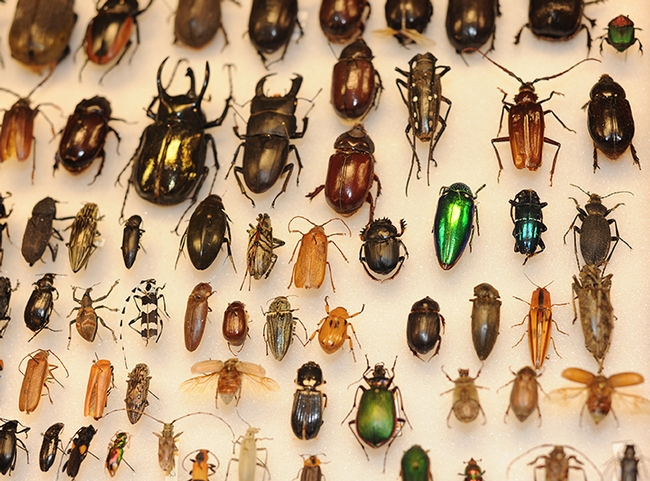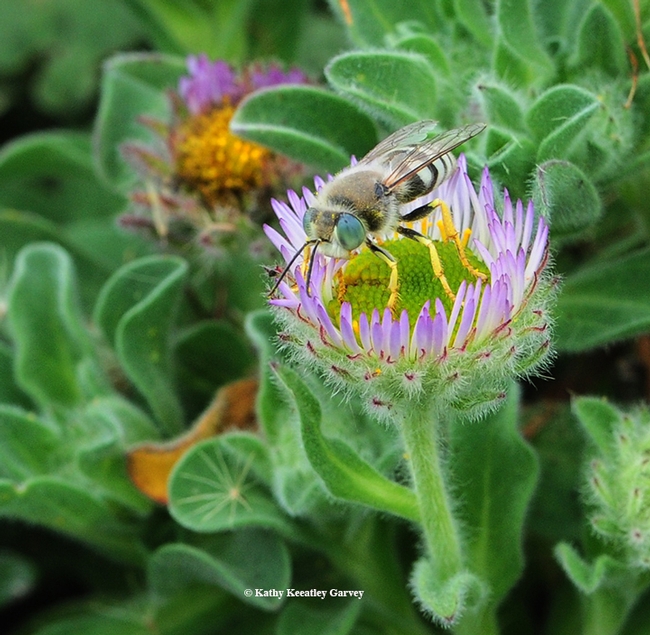- Author: Kathy Keatley Garvey
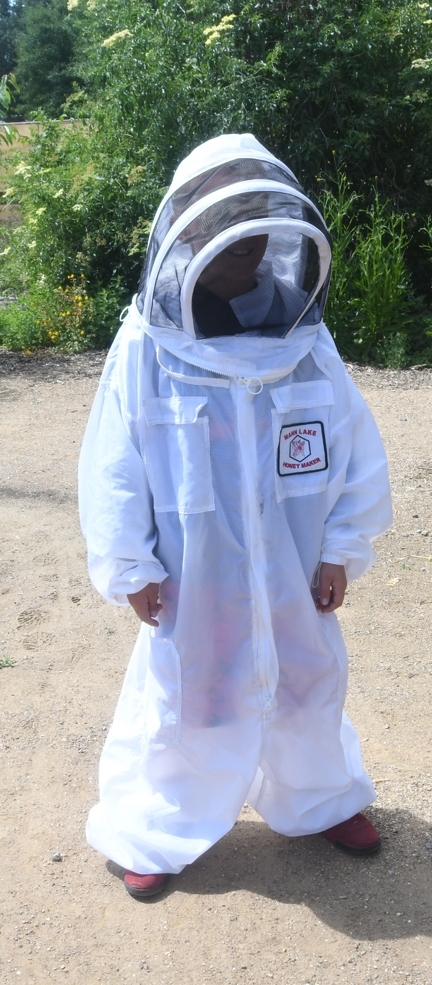
Tomorrow (Saturday, Aug. 18) is National Honey Bee Day.
A small group of beekeepers originated the observance back in 2009 to spotlight bees and beekeeping. They petitioned and obtained a proclamation from the U.S. Department of Agriculture, which set aside the fourth Saturday of August to mark the occasion.
It's important to educate the public--especially children, our next generation--about the importance of honey bees and other pollinators.
And that's just what the UC Davis Pollination Education Program is doing, thanks to California State Extension apiculturist and faculty member Elina Lastro Niño of the UC Davis Department of Entomology and Nematology.
“This program was developed to ensure that our young scientists and future voters are aware of the importance of pollinators to our food production and ecosystems," Niño related. "We are also very excited to partner with programs across the university to recruit and support UC Davis students in becoming interns and mentors for the program. This program has already generated so much excitement with the kids and we want to provide this opportunity to as many schools as possible.”
We recently watched a group of third graders from Amador County learn about honey bees and other pollinators when Nino and her colleagues hosted the youngsters in the Department of Entomology and Nematology's bee garden, the Häagen-Dazs Honey Bee Haven. A half-acre public garden installed in 2009 on Bee Biology Road, west of the central campus, it provided the perfect place for the five interactive learning stations.
Some highlights...
Laura Brutscher
Postdoctoral scholar Laura Brutscher of the Niño lab kneels by an educational beekeeping display: a beehive, a smoker, a hive tool and beekeeper protective gear. She discusses the residents of the hive: the queen, worker bees (females) and drones (males). The third-graders, sitting, standing or kneeling in the garden, listen to her wide-eyed.
“Who knows what the job of a drone is?” Brutscher asks.
A hand shoots up. “The drones protect the queen!” a boy declares.
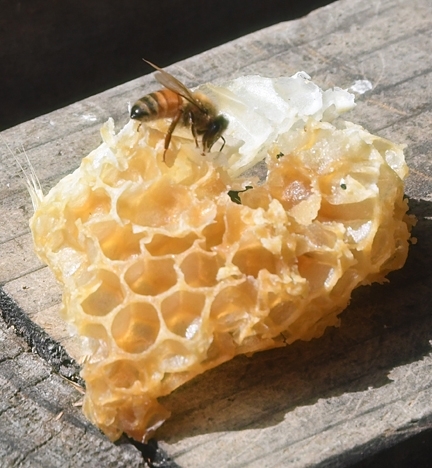
The students learn that the honey bee colony is a matriarchal society. The females do all the work, performing specific tasks with job titles such as nurse maids, nannies, royal attendants, builders, architects, foragers, dancers, honey tenders, pollen packers, propolis or "glue" specialists, air conditioning and heating technicians, guards, and undertakers. The queen can lay up to 2000 eggs a day during peak season.
The third graders then suit up, donning assorted beekeeper protective gear. They pose gleefully in oversized suits while adults on the tour--teachers, parents and mentors--photograph them.
Elina Lastro Niño
Niño, who also directs the highly successful California Master Beekeeper Program, explains pollination and how honey bees differ from such generalists as bumble bees and such specialists as squash bees. She invites the students to build their own bee, using pipe cleaners of various lengths to mimic how they are able to pollinate flowers. The youngsters also taste apples, blueberries and almonds. Honey bees, she tells them, pollinate one third of the food we eat.
Charley Nye, beekeeper and manager of the Harry H. Laidlaw Jr. Honey Bee Research Facility, zeroes in on the products of the hive. “When we see bees flying around, what are they doing there?” he asks.
“They're out gathering nectar and pollen,” responds one youngster.
“That's right,” Nye says. He then introduces them to five varietals of honey: almond, coffee, cotton, blackberry, meadowfoam.
The students and adults like the meadowfoam the best. “It tastes like cotton candy!” one girl says, slowly savoring the flavor she found reminiscent of a county fair.
Wendy Mather
Wendy Mather, California Master Beekeeper Program manager, shows the youngsters a bee vacuum device and how to catch and release bees. They examine them close-up. Others at her interactive learning station craft seed cookies, decorated pots, and planted seeds for pollinators. They also view the bee and syrphid (hover) fly specimens loaned by pollination ecologist Neal Williams, UC Davis professor of entomology. The hover fly, sometimes called a flower fly, is a major pollinator.
Another station focuses on solitary bees: leafcutter bees and blue orchard bees. The students paint nest boxes and learn how the native bees differ from honey bees. Honey bees are not natives of America; European colonists brought them to Jamestown, Virginia, in 1622. Honey bees did not arrive in California until 1853, the year a beekeeper installed colonies near San Jose.
Marcel Ramos
Marcel Ramos, lab assistant in the Elina Niño lab, opens a hive inside a netted enclosure and showed the students the queen bee, workers and drones and pulled out frames of honey.
It was indeed, a honey of a day, and the youngsters learned a lot about bees.
The event received financial support from the UC Davis College of Agricultural and Environmental Sciences Programmatic Initiative Grant, the Scott and Liberty Munson Family, and matching funds from Microsoft.
Ron Antone, chair of the Farms of Amador and an Amador County Master Gardener, coordinated the Amador County visit, which drew third-graders from four schools: 67 from Plymouth and Sutter Creek elementary and "about the same number" from Pioneer and Pine Grove elementary. “The tour was coordinated and funded by Farms of Amador,” he said. “We are also associated with the Amador County Farmers Market Association."
“The program presented by Elina and the Häagen-Dazs Honey Bee Haven team was an incredible experience for all involved: students, parents, teachers and mentors from Farms of Amador and Amador County Master Gardeners," Antone said. “I could not have imagined a more successful trip."
UC Davis Resources:
Celebrate bees on Saturday, Aug. 18: The UC Davis Department of Entomology and Nematology's bee garden, the Häagen-Dazs Honey Bee Haven, has scheduled an open house from 10 a.m. to 4 p.m., Saturday, Aug. 18. Saturday is National Honey Bee Day. The event is free and family friendly. The garden is located on Bee Biology Road, west of the central campus.
Activities, according to academic program manager Christine Casey, will include:
- Learn about how to grow healthy fruits and vegetables at home and how to encourage pollinators in the garden for best yield
- See the bees in action in our demonstration garden
- Cooking demonstration and recipe ideas
- Bee and plant experts to answer your questions
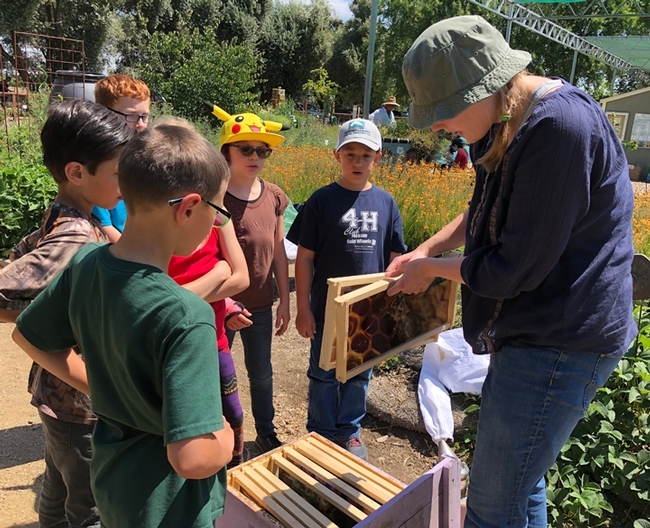
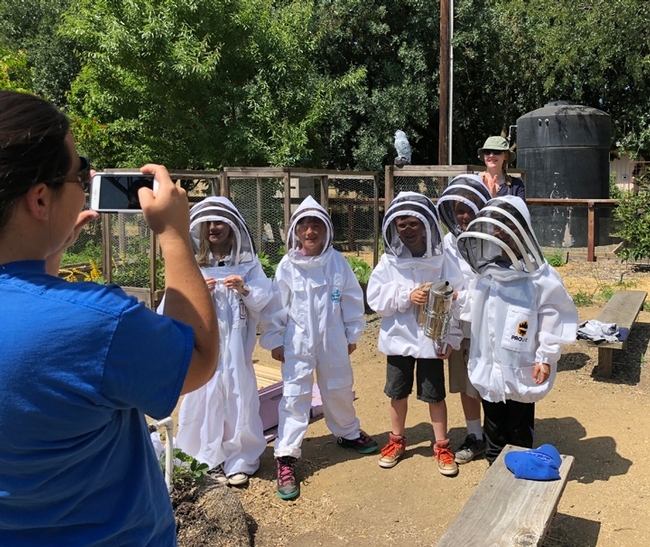
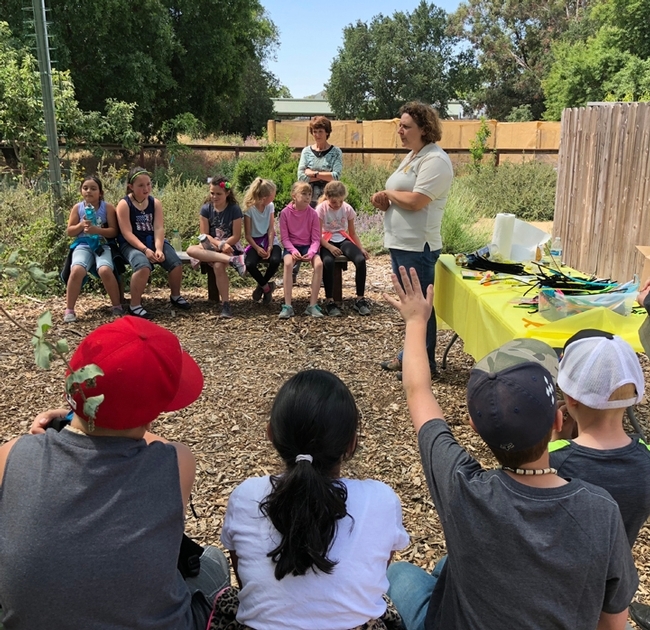
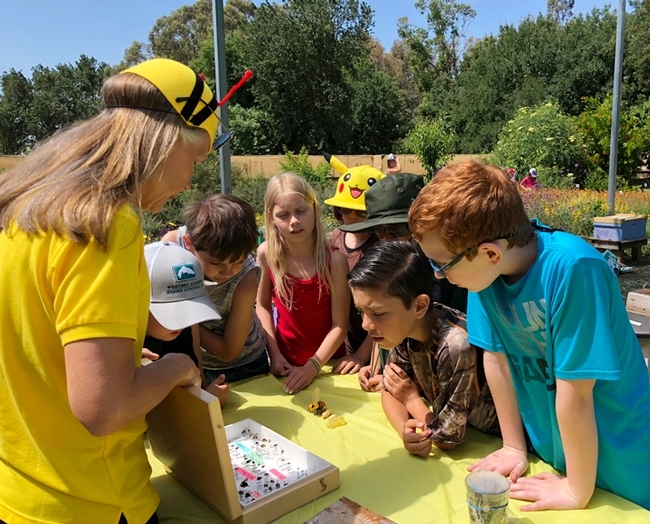
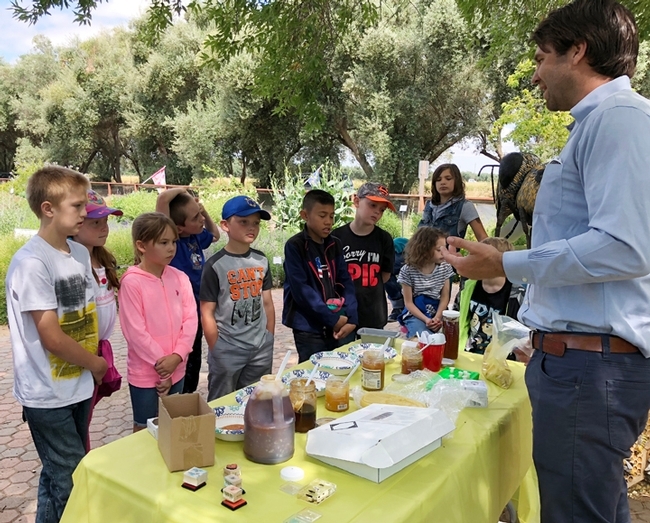
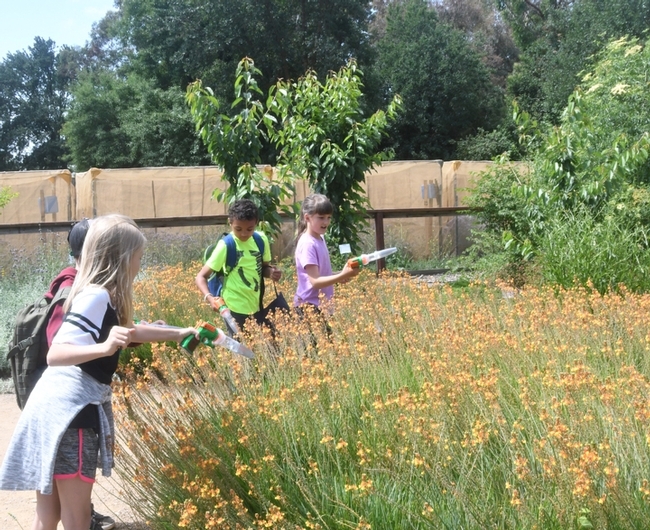
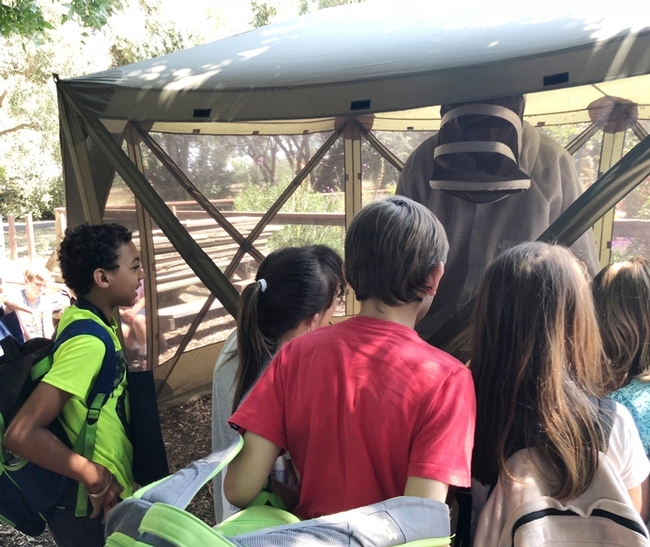
- Author: Kathy Keatley Garvey
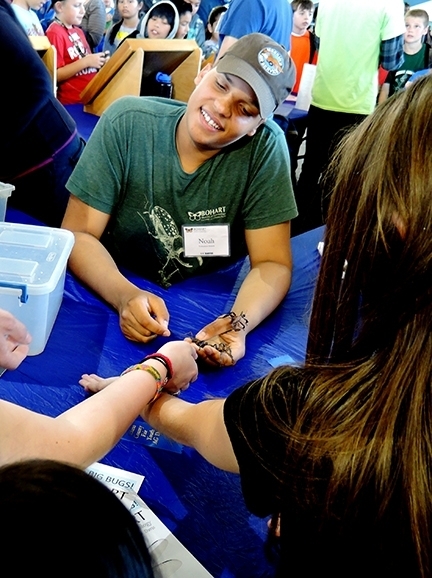
That sign greets visitors to the Bohart Museum of Entomology, University of California, Davis, and that's exactly what Noah Crockette, 18, an intern there since age 11 and the winner of an international beetle research award as a teenager, plans to do.
This week he's already gone far--a distance of more than 2700 miles--from Davis to Ithaca, N.Y., where he is majoring in entomology at Cornell University.
Fondly known as “The Beetle Boy,” Noah won the 2015 Coleopterists' Society Award (senior division) for his project, “Survey of the Dung Beetles of Stann Creek, Belize.”
He volunteers at the Bohart Museum, home of nearly eight million insect specimens, and a live petting zoo of Madagascar hissing cockroaches, walking sticks and tarantulas. He has helped out with open houses, outreach programs and collecting trips.
“Yes, Noah has been volunteering here for quite a few years,” said Lynn Kimsey, director of the Bohart Museum of Entomology and professor of entomology at UC Davis. “We've seen him go from a middle school kid to a very mature 18-year-old. He's a great kid, always ready with a big smile, great attitude and really hard working. Smart, too. He should do very well at Cornell. We already miss him.”

Two Cornell University alumni--Tabatha Yang, the Bohart Museum's education and outreach coordinator, and UC Davis doctoral candidate student Emily Bick of the Christian Nansen lab, serenaded him with the Cornell fight song. Yang's degree is in general biology, and Bick's degree in entomology. After they sang the fight song, they told him how cold the winters are!
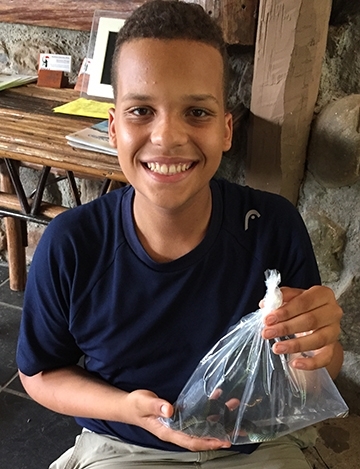
His major advisor is drosophila (fruit flies) expert Patrick O'Grady, who taught at UC Berkeley for 12 years before joining the Cornell faculty last year. His ecology professor is UC Davis alumnus Anurag Agrawal, an ecologist who received his doctorate in 1999, studying with Richard Karban.
His acceptance into Cornell, one of the top-ranked entomology programs in the country, came in 2017. Noah graduated in 2017 from The Met Sacramento High School, and Cornell offered him a one-year student transfer contract for the fall of 2018.
“I have always been interested in bugs but my interest in entomology started in sixth grade,” Noah said. “I mostly became interested in insects through my internship at the Bohart and participating in the undergraduate UC Davis Entomology Club (open to all interested persons). Before then I had only known that I was interested in zoology and started going to the Ent Club after learning about it from talking to (UC Davis forensic entomologist and club advisor) Robert “Bob” Kimsey at UC Davis Picnic Day. After attending the club for awhile, Danielle Wishon (club president and entomology major) and Bob got me connected with the Bohart to start the internship from which my interest grew.”
Career plans? Noah is keeping his options open as to specialty, but he wants to work in research. Beetles fascinate him, especially scarab beetles. “I have a tendency towards scarab beetles,” he said. “I particularly like the tribe Cyclocephalini, the masked chafer beetles. I really like that they are a Dynastines like the Hercules beetles but lack any sort of horns or other glitzy features. Even though they are small and brown, I love the subtle beauty of the markings which remind me of the Rorschach ink tests.
”I also really love venom so I have also thought about going into venom research but would like to grow more familiar with it before considering it more.”
As a Bohart Museum intern and associate, Noah collected insects twice in Belize on Bohart-affiliated collecting trips “where I was able to get field work experience in entomology as well as herpetology and ornithology.” Fran Keller, assistant professor, Folsom Lake College, and David Wyatt, an entomology professor at Sacramento City College, led the collecting trips. Keller, who served as his mentor, received her doctorate in entomology from UC Davis, studying with Lynn Kimsey.
“My last trip to Belize," Noah said, "was when I completed my Coleopterists' Society project in which I designed and constructed 12 baited pitfall traps which I used to survey the dung beetle species on the property as well as determine their preferred bait, between human feces, pig feces, chicken manure, rotten chicken, and rotten fruit."
In his freshman year, Noah taught an entomology class to elementary students, and as a senior project, organized a museum day at Shriners Hospital for Children.
Outside of entomological pursuits, he enjoys hiking, kayaking and birdwatching. “I really love the outdoors,” he said. “Last year after my trip to Belize I was also given the opportunity through my school to go on a month-long backpacking and kayaking trip through the National Outdoor Leadership School (NOLS) in Alaska. I also played rugby for C.K. McClatchy High School during my senior year which was a fun experience and I now plan on continuing with the sport. At home I like to keep reptiles and invertebrates--mostly tarantulas--as pets and enjoy collecting zoology related books and objects.”
During the going-away party, a photo of Noah Crockette flashed on the wall-mounted computer screen. It pictured him at about age 14, enthusiastically working with insects.
Doing what he loves.
Not overlooked was the quote from noted scientist E. O. Wilson “Go as far as you can [young scientists]. The world needs you badly."
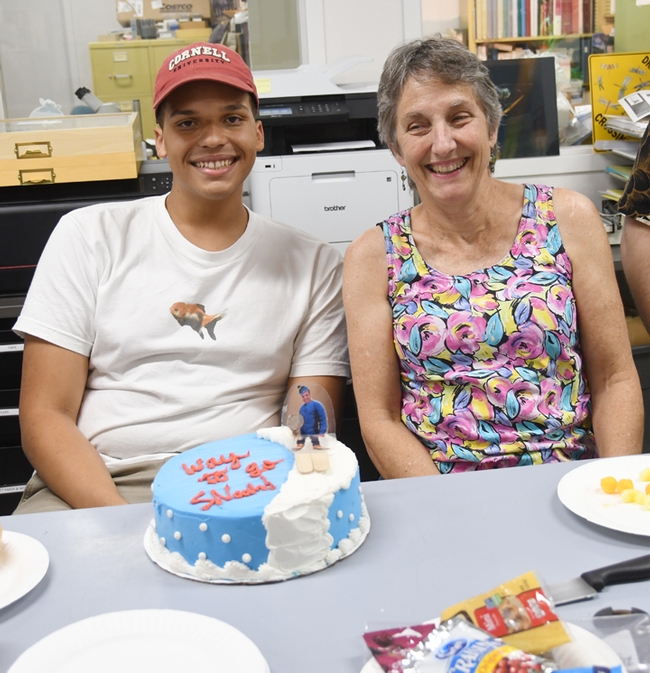
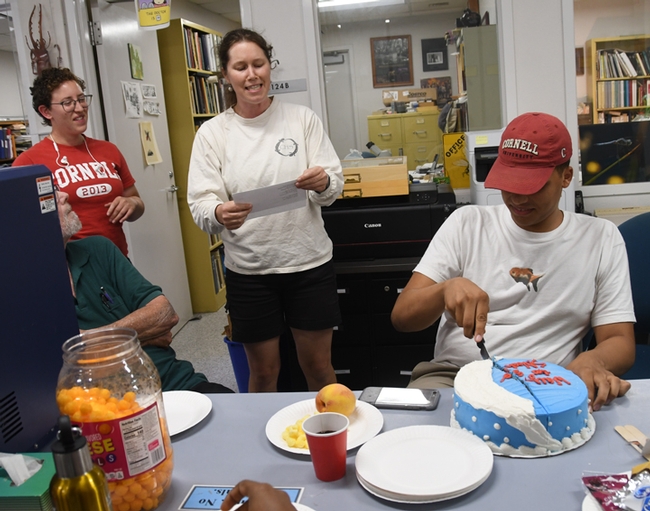
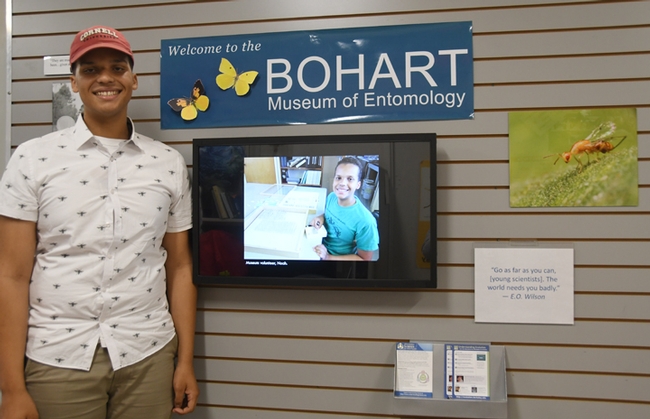
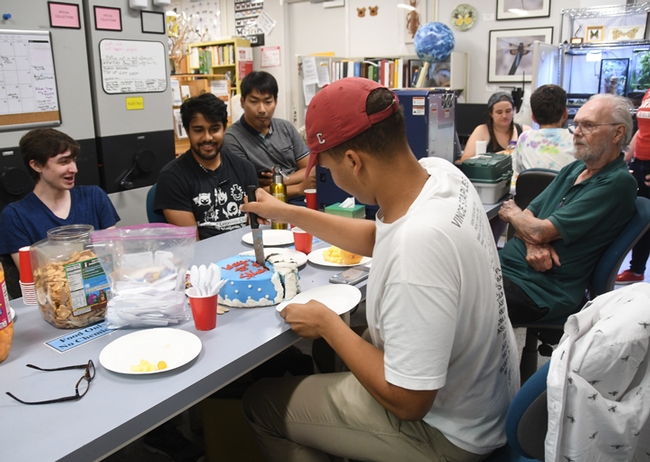
- Author: Kathy Keatley Garvey
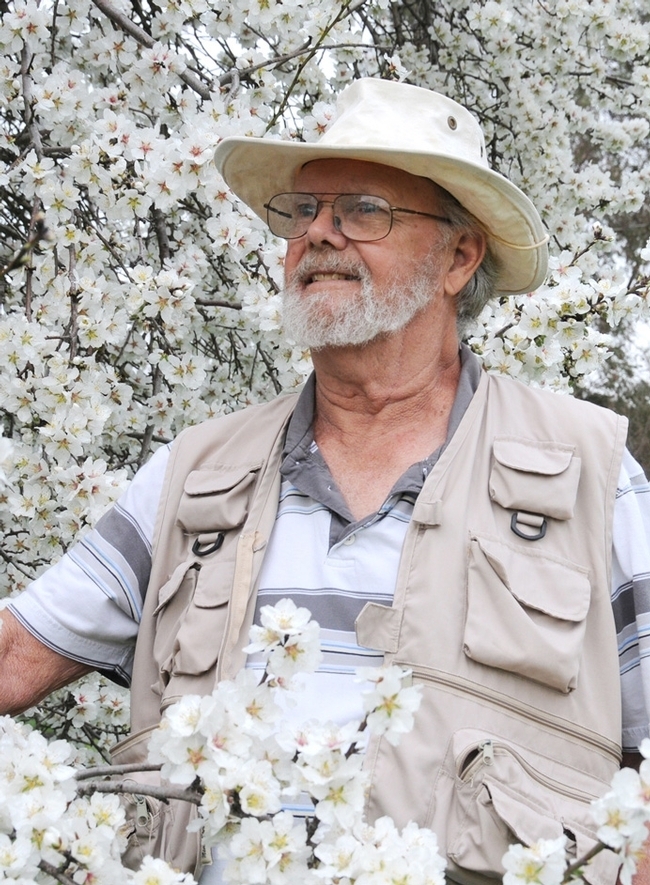
Ah, pillow fights, popcorn, and marathon movies on TV, you ask?
No. "Boys' Night Out" is when the longhorned male bees in our pollinator garden in Vacaville engage in sleepovers on our Mexican sunflowers (Tithonia) and other blossoms.
At night, the girls sleep inside their nests, and the boys cluster on flowers.
Lately, we've been admiring a trio of boys--Melissodes (possibly M. robustior, as identified by Robbin Thorp, distinguished emeritus professor of entomology at the University of California, Davis)--bunking down on a Tithonia. Every day, around sunset, they head over to the same flower, arrange themselves in comfortable sleeping positions (hey, quit kicking me), and it's nighty-night! When the sun rises, they vacate the bedroom. Sometimes it's earlier than planned, no thanks to buzzing bumble bees, carpenter bees and honey bees foraging around them and disturbing their beauty sleep. The nerve!
Other species of male longhorned bees--including Melissodes agilis and Svastra obliqua--sleep on flowers at night as well.
"Most frequently, the boy bee overnight clusters are single-species clusters," says Thorp, co-author of California Bees and Blooms, a Guide for Gardeners and Naturalists, with UC-affiliated authors Gordon Frankie, Rollin E. Coville, and Barbara Ertter.
Thorp, who holds a doctorate in entomology from UC Berkeley and taught entomology at UC Davis from 1964 to 1994, continues to "bee involved" in research, writings, bee identification and public outreach. He teaches annually at The Bee Course (American Museum of Natural History), at the Southwestern Research Station, Portal, Ariz. The nine-day intensive course is offered for conservation biologists, pollination ecologists and other biologists who want to gain greater knowledge of the systematics and biology of bees.
In a previous Bug Squad blog, Thorp responded to a reader's inquiry about "stings" from the clustering bees. "Boy bees cannot sting," he pointed out. "They lack a stinger which is a modified ovipositor in their wasp ancestors. Occasionally a girl bee may spend the night out if she is caught by sudden drop in temperature. Usually she will not be part of a group sleep over. So don't attempt to handle unless you are confident you can tell boy bees from girl bees or they are too sleepy to defend themselves."
The reader also asked: "Typically how close to the girls' nest(s) do the boys' slumber? I want to try and make sure I don't touch it when planting at end of summer."
"Boy sleeping aggregations are based on a suitable perch and not related to where females are nesting, but probably no more than 100 yards from the nearest female nest," Thorp answered. "Females nest in the ground and have rather distinctive round holes about the diameter of a pencil or slightly smaller, sometimes with small piles of dirt around them looking like mini-volcanos. The holes may be widely separated or clustered together depending on the species, but each female digs her own burrow."
The reader also wondered: "When watching the boys tonight, about ten of them started waking up and kicking each other. They finally settled down and started to nestle back in for the 'night'--it was only 6 p.m.--but I wasn't sure if my presence was getting them riled or they tend to act like kids sharing a bed?"
Said Thorp: "The boys usually settle in as the light dims in the evening. Cool, and drizzly conditions may modify bed time. Each establishes his own spot, so there may be some jostling for position initially."
Longhorned bees are among the more than 1600 species of undomesticated bees that reside in California. In their book, California Bees and Blooms, the authors focus on 22 of the most common genera and the flowers they frequent. Meanwhile, check out Frankie's UC Berkeley Urban Bee Lab website to read more about native bees and the exciting research underway.
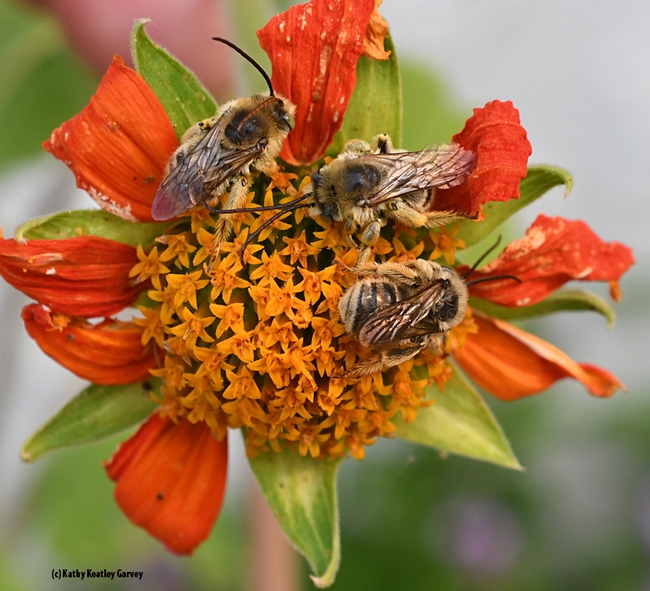
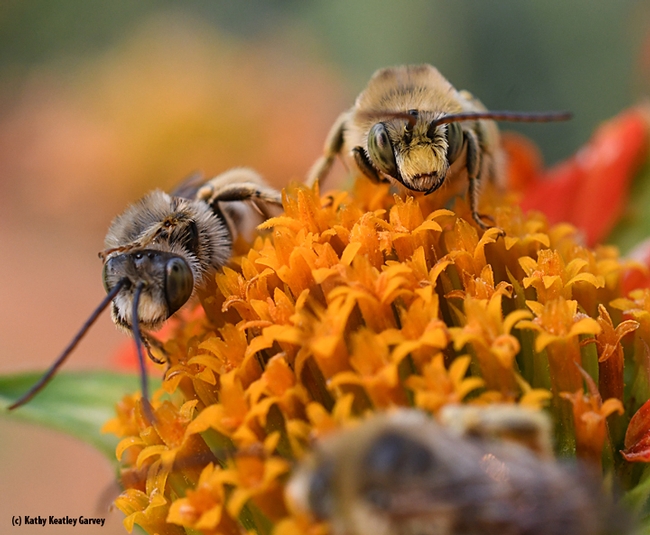

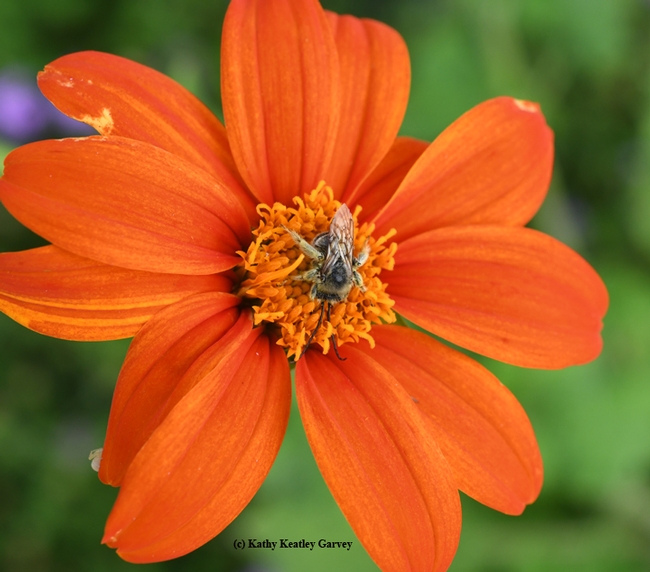
- Author: Kathy Keatley Garvey
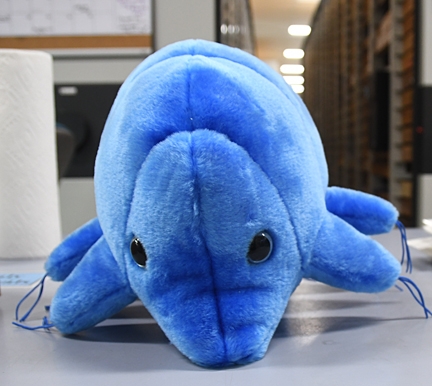
There's a new bear in town.
Stuiffed toy animals resembling tardigrades, aka "water bears," are all the rage at the Bohart Museum of Entomology's year-around gift shop at the University of California, Davis.
The bright blue plush toys are just as cuddly, fluffy and pudgy--if not more so--than the traditional teddy bear.
Lynn Kimsey, director of the Bohart Museum and professor of entomology, UC Davis Department of Entomology and Nematology, wrote about the tardigrades in her newsletter several years ago.
The water bear "has to be one of the most peculiar and indestructible groups of animals known," she wrote. The microscopic and nearly indestructible tardigrade can survive being heated to 304 degrees Fahrenheit or being chilled for days at -328 F. And, even if it's frozen for 30 years, it can still reproduce. See video on EurekAlert.
They belong to their own phyllum, the Tardigrada (meaning "slow steppers"), and to date there are some 1,500 described species throughout the world. "Tardigrades can survive high pressures of more than 1,200 atmospheres found in the bottom of the abyss," Kimsey related. "They can tolerate 1,000 times more ionizing radiation than other animals."
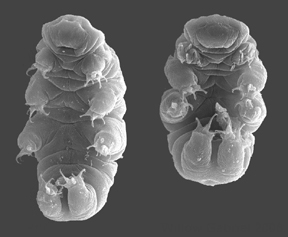
"This collection is the result of years of collecting, mounting, imaging, and identifying by former collection manager Bob Schuster and emeritus professor Al Grigarick and their collaborators," she noted.
What's the water bear look like? It has a barrel-shaped body, eight pudgy legs, and the adults usually range from 0.3 to 0.5 mm in length.
German zoologist Johann August Ephraim Goeze (1731-1793) first described the critters in 1773, referring to them as "kleiner Wasserbär," or "little water bears."
They're easiest to find on lichens and mosses, Kimsey says, but they can also be found on beaches, in the subtidal zone, freshwater sediments, soil, hot springs and even on barnacles. They've been found "high in the Himalayas to down in the deep sea." They've even been found in the interior of Antarctica.
They mostly feed on plants or bacteria "but some are predators on smaller tardigrades," Kimsey says. They use the stylets in their tubular mouth (snout) to pierce "individual plant or bacterial ells or small invertebrates."
Why is the water bear so indestructible? In research published in 2016, geneticist Takekazu Kunieda and his colleagues from the University of Tokyo found that the water bear expresses a tardigrade-specific protein that binds itself to DNA. This acts like a "shield against x-ray radiation, preventing the DNA from snapping apart," according to an article published in Gizmodo.
Bottom line: the real "water bear" is definitely less destructible than its huggable, plush counterpart in the Bohart gift shop.
(Editor's note: The Bohart Museum of Entomology will host an open house, themed "Extreme Insects: Fire and Ice," from 1 to 4 p.m., Sunday, Aug. 19 in Room 1124 of the Academic Surge Building on Crocker Lane, UC Davis campus. It is free and family friendly. More information is available on the website or by contacting (530) 752-0493 or emailing bmuseum@ucdavis.edu. UC Davis student and Bohart associate Emma Cluff, pictured, is helping coordinate the event.)
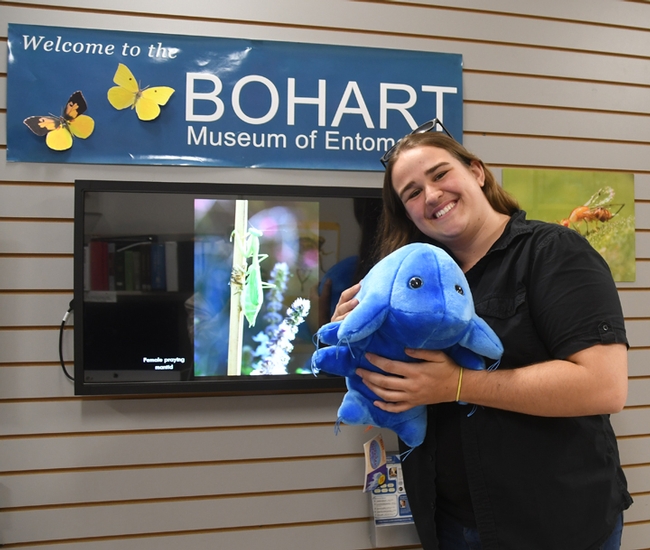
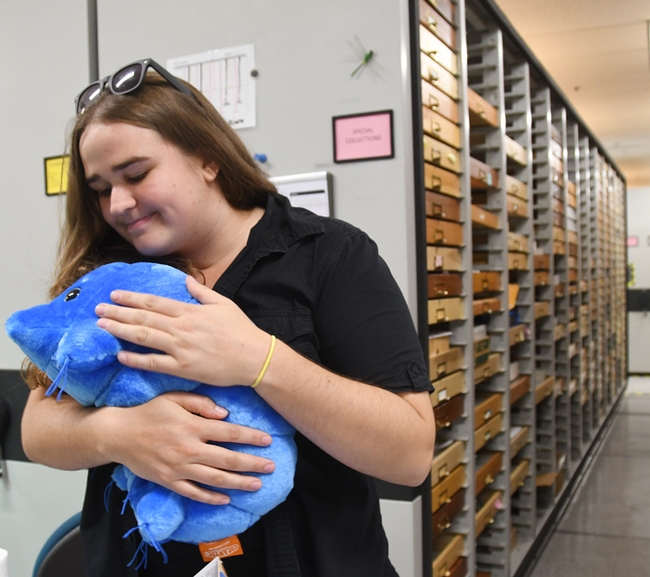
- Author: Kathy Keatley Garvey
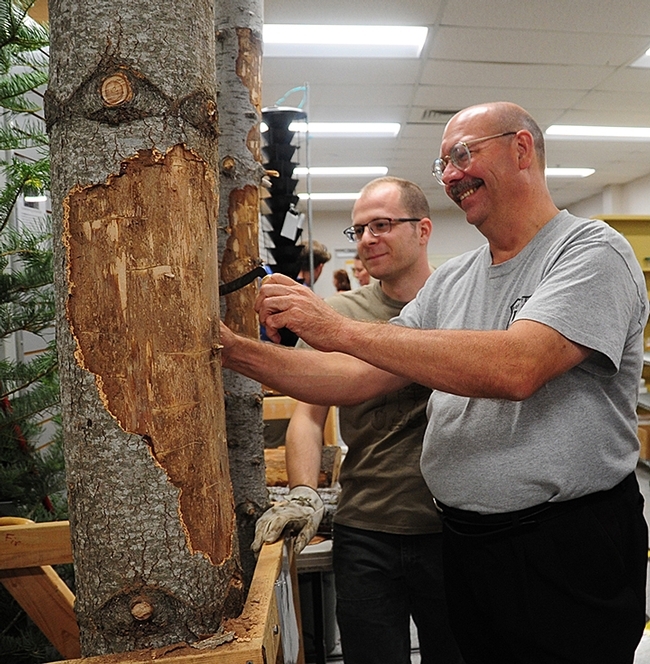
Have you ever seen an ambrosia beetle, a red turpentine beetle, an ice cricket, a brine fly or a sand wasp?
You will if you attend the UC Davis Bohart Museum of Entomology open house on “Extreme Insects: Fire and Ice,” on Sunday afternoon, Aug. 19.
The public event, to take place from 1 to 4 p.m. in Room 1124 of the Academic Surge Building, Crocker Lane, is free and family friendly. It will emphasize "fire and insects."
“There are a number of species that are specifically attracted by smoke to damaged trees,” said Lynn Kimsey, director of the Bohart Museum and professor of entomology at UC Davis. “Wildland fire fighters hate them because some of the beetles fly at them, crawling into their turnouts and biting them. Fire insects include jewel beetles, some horntail wasps and a few others."
In addition to fire insects, Kimsey said that the Bohart open house will cover other insects adapted to extremes:
- Ice: ice crickets and ice flies, both native to California
- Extreme acid: midges that live only in highly acidic mine run-off
- Hot water: midges found in hot springs just below the boiling point
- Salt: the brine flies of Mono Lake.
- Desert: sand wasps
Regarding the beetles that attack the firefighters, these are “The flatheaded borers (Buprestidae) and they will actually nip the firefighters as they land,” said chemical ecologist Steve Seybold with the USDA Forest Service, Pacific Southwest Research Station, Davis, and a lecturer/researcher with the UC Davis Department of Entomology and Nematology.
Insects that like ethanol/burned phloem include the red turpentine beetle, the ambrosia beetles, the "sour cambium" beetles, and some of the larger woodborers, Seybold said. “These are the 'undertakers' of the trees, if you will. Certain bark and ambrosia beetles specialize in colonizing burned tissue that gives off ethanol as a sign of fermentation. These insects wait until things have cooled off a bit before they bore into the trees."
"Often when you visit a burned area," Seybold said, "you'll see piles of white dust coming out of the trees that have blackened bark. This dust is made by ambrosia beetles--and other larger woodborers--that can make use of the carbon that is still present in these moribund trees. Ambrosia beetles 'consume' this carbon indirectly by farming fungi in their galleries. The fungus serves as a conduit for the nutrients in the wood. Some of the larger woodboring insects have other adaptations like specialized enzymes that degrade cellulose or hemicellulose."
Seybold called attention to an article titled “Attraction of Melanophila Beetles by Fire and Smoke,” authored by noted beetle expert E. Gorton Linsley (1910-2000) and published in April of 1943 in Scientific Notes, the Journal of Economic Entomology. Linsley, who received his doctorate from UC Berkeley in 1938, wrote that thousands of cigarette smokers at the UC Berkeley football games were complaining of beetles swarming into the stadium and biting their hands and necks.
The smoke on "still days sometimes hangs like a haze over the stadium during a big game," wrote Linsley, identifying the beetles as Melanophilaconsputa Lec. and M. acuminata (family Buprestidae). M. consputa is commonly called “the charcoal beetle.”
Linsley also reported receiving "complaints from sawmill operators, fire fighters and smelter plant workers regarding annoyance by buprestid beetles of the genus Melanophila. These beetles appear to be greatly stimulated by heat and attracted by smoke. They normally breed in fire-scarred pines and under ordinary conditions, they are rarely encountered in nature. However, on hot days during the dry season, especially in late summer and fall, they sometimes fly in unbelievable numbers to forest fires, burning refuse dumps, refineries, smelter plants, etc.”
Wildfires continue to rage in California. As of Aug. 13, the 5,255 California wildfires this year have burned 958,812 acres, according to the California Department of Forestry and Fire Protection and the National Interagency Fire Center. To date, the still-active Mendocine Complex fire, the largest wildfire in California history, has charred more than 344,000 acres.
The Bohart Museum open house also will include a family craft activity involving extreme insects. The museum houses a global collection of nearly eight million specimens and is the home of the seventh largest insect collection in North America, and the California Insect Survey, a storehouse of the insect biodiversity. It also houses a live "petting zoo" of Madagasar hissing cockroaches, walking sticks, tarantulas and praying mantids, and a year-around gift shop, stocked with T-shirts, sweatshirts, books, jewelry, posters, insect-collecting equipment and insect-themed candy.
The Bohart Museum's regular hours are from 9 a.m. to noon and 1 to 5 p.m. Mondays through Thursdays. It is closed to the public on Fridays, Saturdays and Sundays and on major holidays. Admission is free. More information on the Bohart Museum is available on the website or by contacting (530) 752-0493 or emailing bmuseum@ucdavis.edu.
